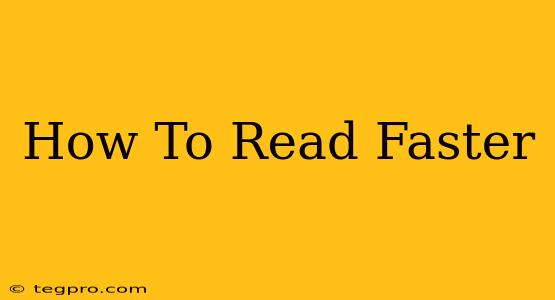Are you struggling to keep up with your reading list? Do you wish you could absorb information more quickly and efficiently? Learning how to read faster is a valuable skill that can significantly improve your productivity and comprehension. This comprehensive guide will equip you with practical techniques and strategies to boost your reading speed without sacrificing understanding.
Understanding Your Current Reading Habits
Before diving into speed-reading techniques, it's crucial to understand your current reading habits. Are you a slow, methodical reader, or do you tend to skim and scan? Identifying your strengths and weaknesses will help you tailor your approach. Consider these questions:
- What is your average reading speed? You can measure this by timing yourself reading a page or chapter.
- What challenges do you face while reading? Do you find yourself rereading sentences often? Do you get easily distracted?
- What types of materials do you read most often? Your approach may vary depending on whether you're reading fiction, non-fiction, or technical documents.
Essential Techniques for Speed Reading
Several techniques can significantly improve your reading speed. Here are some of the most effective:
1. Minimize Subvocalization
Subvocalization is the habit of silently pronouncing words as you read. This significantly slows down your reading speed. To overcome subvocalization:
- Practice actively suppressing inner speech. Focus on visually recognizing words instead of sounding them out.
- Use a pointer. A finger or pen can guide your eyes and help maintain focus, reducing the urge to subvocalize.
- Listen to music. Background music can help distract your inner voice.
2. Expand Your Visual Span
Your visual span refers to the number of words you can take in at a glance. Improving this is key to reading faster:
- Practice reading multiple words at once. Try to avoid focusing on individual words.
- Use a wider visual field. Try to take in larger chunks of text at a time.
3. Eliminate Regressions
Regressions are the habit of rereading previously read sentences or words. This slows your reading speed considerably. To avoid regressions:
- Maintain your focus. Try to keep your eyes moving forward.
- Improve concentration. Minimize distractions and ensure you are in a comfortable and quiet environment.
4. Skimming and Scanning
Skimming and scanning are powerful techniques for quickly extracting key information.
- Skimming: Use this technique to quickly grasp the main ideas of a text. Read the introduction, headings, subheadings, and concluding paragraphs.
- Scanning: Use this technique to locate specific pieces of information, such as names, dates, or facts.
5. Improve Your Vocabulary
A strong vocabulary directly impacts your reading speed and comprehension. The more words you know, the faster you can process information.
- Read widely. The more you read, the wider your vocabulary will become.
- Use a dictionary. Look up words you don't understand.
- Use vocabulary-building apps.
Practice Makes Perfect
Consistent practice is crucial for developing speed reading skills. Start with shorter texts and gradually increase the length and complexity of your reading material. Remember to focus on comprehension as well as speed. The goal is to read faster without sacrificing understanding.
Tools and Resources to Enhance Your Speed Reading
Several apps and websites offer speed reading exercises and training programs that can help you improve your skills. While this article doesn't directly endorse or link to specific products, exploring such tools could be beneficial for your practice.
Conclusion: Unlock Your Reading Potential
Mastering speed reading can significantly enhance your productivity and knowledge acquisition. By implementing these techniques and practicing consistently, you can unlock your reading potential and enjoy the benefits of faster, more efficient reading. Remember, it's a journey, not a race – focus on gradual improvement and enjoy the process of expanding your knowledge.

